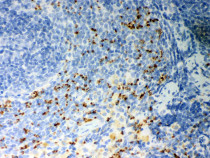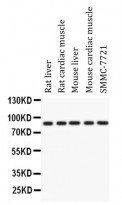ARG40705
anti-CD36 antibody
anti-CD36 antibody for IHC-Formalin-fixed paraffin-embedded sections,Western blot and Human,Mouse,Rat
Overview
| Product Description | Rabbit Polyclonal antibody recognizes CD36 |
|---|---|
| Tested Reactivity | Hu, Ms, Rat |
| Tested Application | IHC-P, WB |
| Host | Rabbit |
| Clonality | Polyclonal |
| Isotype | IgG |
| Target Name | CD36 |
| Antigen Species | Human |
| Immunogen | Synthetic peptide corresponding to aa. 31-66 of Human CD36. (DLLIQKTIKKQVVLEEGTIAFKNWVKTGTEVYRQFW) |
| Conjugation | Un-conjugated |
| Alternate Names | GPIV; CHDS7; Platelet glycoprotein 4; CD antigen CD36; PAS-4; PASIV; Glycoprotein IIIb; PAS IV; GPIIIB; FAT; SCARB3; GP3B; Leukocyte differentiation antigen CD36; Platelet collagen receptor; BDPLT10; Thrombospondin receptor; GP4; Fatty acid translocase; Platelet glycoprotein IV |
Application Instructions
| Application Suggestion |
|
||||||
|---|---|---|---|---|---|---|---|
| Application Note | * The dilutions indicate recommended starting dilutions and the optimal dilutions or concentrations should be determined by the scientist. |
Properties
| Form | Liquid |
|---|---|
| Purification | Affinity purification with immunogen. |
| Buffer | 0.2% Na2HPO4, 0.9% NaCl, 0.05% Sodium azide and 5% BSA. |
| Preservative | 0.05% Sodium azide |
| Stabilizer | 5% BSA |
| Concentration | 0.5 mg/ml |
| Storage Instruction | For continuous use, store undiluted antibody at 2-8°C for up to a week. For long-term storage, aliquot and store at -20°C or below. Storage in frost free freezers is not recommended. Avoid repeated freeze/thaw cycles. Suggest spin the vial prior to opening. The antibody solution should be gently mixed before use. |
| Note | For laboratory research only, not for drug, diagnostic or other use. |
Bioinformation
| Database Links | |
|---|---|
| Gene Symbol | CD36 |
| Gene Full Name | CD36 molecule (thrombospondin receptor) |
| Background | The protein encoded by this gene is the fourth major glycoprotein of the platelet surface and serves as a receptor for thrombospondin in platelets and various cell lines. Since thrombospondins are widely distributed proteins involved in a variety of adhesive processes, this protein may have important functions as a cell adhesion molecule. It binds to collagen, thrombospondin, anionic phospholipids and oxidized LDL. It directly mediates cytoadherence of Plasmodium falciparum parasitized erythrocytes and it binds long chain fatty acids and may function in the transport and/or as a regulator of fatty acid transport. Mutations in this gene cause platelet glycoprotein deficiency. Multiple alternatively spliced transcript variants have been found for this gene. [provided by RefSeq, Feb 2014] |
| Function | Binds to collagen, thrombospondin, anionic phospholipids and oxidized low-density lipoprotein (oxLDL). May function as a cell adhesion molecule. Directly mediates cytoadherence of Plasmodium falciparum parasitized erythrocytes. Binds long chain fatty acids and may function in the transport and/or as a regulator of fatty acid transport. Receptor for thombospondins, THBS1 AND THBS2, mediating their antiangiogenic effects. As a coreceptor for TLR4-TLR6 heterodimer, promotes inflammation in monocytes/macrophages. Upon ligand binding, such as oxLDL or amyloid-beta 42, rapidly induces the formation of a heterodimer of TLR4 and TLR6, which is internalized and triggers inflammatory response, leading to NF-kappa-B-dependent production of CXCL1, CXCL2 and CCL9 cytokines, via MYD88 signaling pathway, and CCL5 cytokine, via TICAM1 signaling pathway, as well as IL1B secretion. [UniProt] |
| Cellular Localization | Cell membrane; Multi-pass membrane protein. Membrane raft. Golgi apparatus. Apical cell membrane. Note=Upon ligand-binding, internalized through dynamin-dependent endocytosis. [UniProt] |
| Calculated MW | 53 kDa |
| PTM | N-glycosylated and O-glycosylated with a ratio of 2:1. Ubiquitinated at Lys-469 and Lys-472. Ubiquitination is induced by fatty acids such as oleic acid and leads to degradation by the proteasome (PubMed:21610069, PubMed:18353783). Ubiquitination and degradation are inhibited by insulin which blocks the effect of fatty acids (PubMed:18353783). [UniProt] |
Images (2) Click the Picture to Zoom In
-
ARG40705 anti-CD36 antibody IHC-P image
Immunohistochemistry: Paraffin-embedded Rat spleen tissue stained with ARG40705 anti-CD36 antibody.
-
ARG40705 anti-CD36 antibody WB image
Western blot: 50 µg of Rat liver, 50 µg of Rat cardiac muscle, 50 µg of Mouse liver, 50 µg of Mouse cardiac muscle and 40 µg of SMMC-7721 whole cell lysates stained with ARG40705 anti-CD36 antibody at 0.5 µg/ml dilution.







